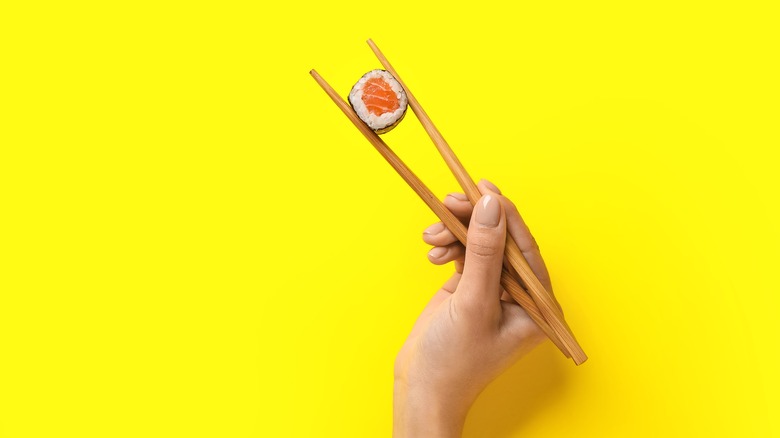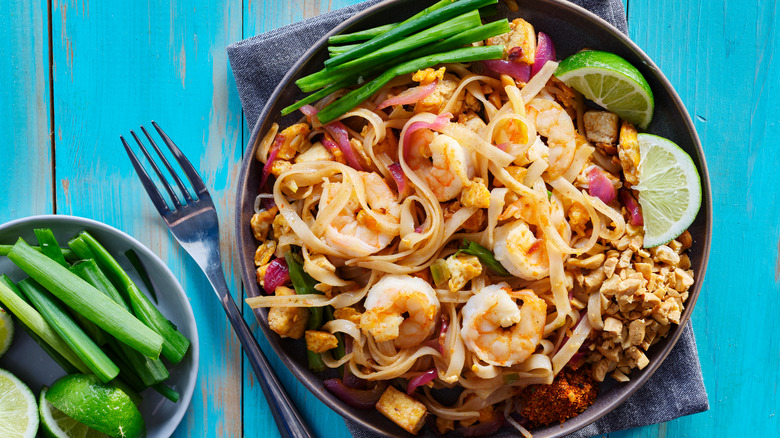Why Chopsticks Are Jet Tila's No. 1 Thai Restaurant Red Flag
If you've ever been to a Thai restaurant you might have thought it was odd that you had to request some chopsticks for your green curry. It might have seemed even odder if you were denied those chopsticks because they simply didn't have any. In America, chopsticks seem like an essential element of any dining experience that could trace its origins back to the Asian continent. The fact of the matter though is that chopsticks aren't all that common in Thailand.
Celebrity chef Jet Tila told Insider that seeing chopsticks at a Thai restaurant should be a red flag for diners.
"If they set the table automatically with chopsticks, and they're not a noodle house, that usually tells me they're kind of pandering more to an American-style restaurant," said Tila.
While he's explored a wide variety of Asian cuisines, Tila certainly knows what it takes to serve authentic Thai food. Tila's family opened the first Thai grocery store in Los Angeles back in the 1970s and started working in the market and restaurants while he was still a child. He's also been recognized by the Royal Thai Consul-General as the inaugural Culinary Ambassador of Thai Cuisine.
Chopsticks at a Thai restaurant might not be a sign that you should head for the door, but they're a definite red flag for Tila considering their role in Thai cuisine.
Why Thai restaurants don't use chopsticks
The reason that many Thai restaurants don't set the table with chopsticks is that it is more common to eat with a knife and spoon. This practice was first adopted in Siam (Thailand's former name) during the reign of King Rama III in the 18th and 19th centuries but failed to catch on initially. It was more typical for most Siamese to eat their food using their hands instead.
In the late 19th century King Rama V then started to show interest in developing Siam into a nation that would match the great European powers. The King sent his children to European colleges, employed Westerners in his home (a la The King and I), and adopted Western dining practices as well. This included the use of forks and spoons, though knives were omitted because they were viewed as weapons.
Today, the common dining method is to use a fork in the left hand to push food onto the spoon in your right hand before bringing it to your mouth.
"If a Thai restaurant sets with a spoon and a fork, that's gonna tell me that they're slightly more authentic because the proper way to eat Thai food, you know, with Jasmine rice, is fork and spoon," Tila told Insider.
Thai restaurant green flags
Chopsticks at the table might mean you should stay away, but there are also plenty of signs at Thai restaurants which tell you that you're in for a more authentic experience. Tila told Insider that one sign you're in capable hands is when the menu has less common dishes. This shows that the restaurant is well-studied in Thai cuisine, and is trying to bring something authentic and unique to your dining experience. This is especially telling because of the highly standardized menu of many American Thai restaurants. There are an endless number of great Thai dishes out there, and it can pay to go somewhere that has more than just the classic Pad Thai.
Another good sign is that there are several different noodle options. Thai cuisine makes use of rice, wheat, mungbean, and egg noodles in a variety of shapes. If you're only seeing one or two on the menu then you likely aren't getting the most genuine expression of Thai cuisine. If you choose to order some of these noodles, then remember that it may be appropriate to ask for chopsticks to do so. Chinese-style noodle dishes that are served in a bowl are one of the only foods that Thai people will use chopsticks to eat, though other dishes served on flat plates should be eaten with a spoon and fork.


